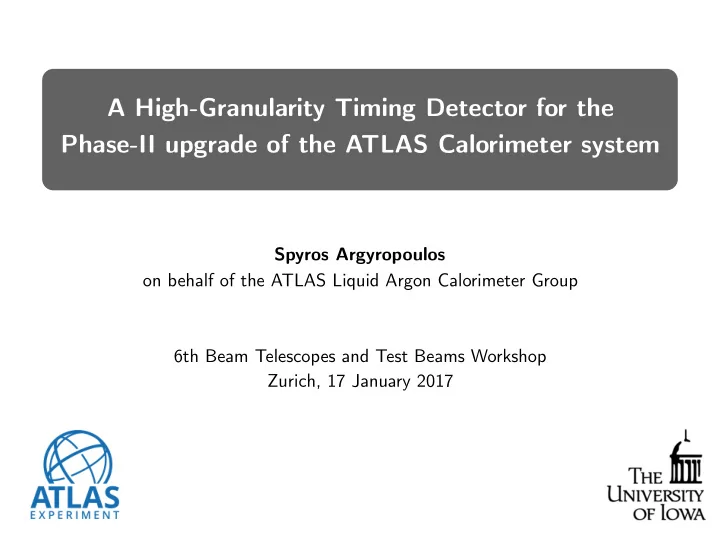

A High-Granularity Timing Detector for the Phase-II upgrade of the ATLAS Calorimeter system Spyros Argyropoulos on behalf of the ATLAS Liquid Argon Calorimeter Group 6th Beam Telescopes and Test Beams Workshop Zurich, 17 January 2017
Overview • Motivation & detector requirements • Expected gains in performance & physics • Sensors tests • Detector assembly 2
Motivation & Requirements
HL-LHC: the problem with pile-up • Pile-up at HL-LHC: < μ > = 200 ➡ 1.6 vertices/mm on average ➡ Need σ (z 0 ) ≲ 0.6 mm for track-vertex association Track resolution - Upgraded tracker 0.6 mm Problem: ITk doesn’t have enough resolution in the forward region ➡ Reduced pile-up jet rejection ➡ Reduced lepton isolation e ffi ciency ➡ Reduced b-tagging performance 4
Pile-up mitigation with timing • Use 2-dimensional track information: z-position & timing z 0 t Pile-up t 0 Hard Scatter Pile-up z • Timing helps reject tracks from PU vertices at same z but di ff erent t • Expected timing resolution: 30 ps • Timing spread for nominal beamspot: 175 ps ➡ Improve pile-up rejection by x6 5
Design requirements for HGTD • Coverage ➡ Replace MBTS: 2.4 < | η | < 4.0 ➡ Active area: 120-640 mm • Radiation hard up to 4.5 · 10 15 n eq /cm 2 and 4.5 MGy • Good timing resolution resolution: 30ps/track ➡ Si-based LGAD sensors (thickness ≤ 300 μ m) ➡ 2-3 layers (replacement of inner ring | η | > 3.2 at half life of HL-LHC) • < 10% occupancy ➡ sensor size 1.3 x 1.3 mm 2 6
Expected gains in performance & physics
Performance HS jet e ffi ciency vs η Light-jet tagging e ff . vs η ✓ x4 improvement in PU jet rejection ✓ With HGTD performance in forward region similar to barrel ➡ Important for channels with forward jets ✓ x4 improvement of l-jet rejection at high η ➡ Important for channels with forward b-jets ✓ 15% improvement in lepton isolation e ffi ciency 8
Physics • Expect improvements in final states with • forward jets ⇒ VBF Higgs (8% improvement of sensitivity) • forward b-jets ⇒ tH (11% improvement of sensitivity) VBF H → WW* tH(bb) • More ideas under study • Impact on channels with forward electrons ⇒ sin θ W measurement • VBF H → ττ , VBF production of BSM resonances • Long-lived BSM particles with forward signature • Online luminosity determination 9
Sensors tests
Sensor requirements σ 2 = σ 2 Landau + σ 2 jitter + σ 2 time-walk + σ 2 TDC • Digitisation granularity • Varying density of e-h pairs along particle path t rise ➡ Thin sensor to σ jitter , σ time-walk ∝ Signal / Noise minimise fluctuations ➡ Low noise (gain) ➡ Thin (small t rise ) Low Gain Avalanche Detectors ✓ Moderate gain (increase signal, limit noise) ✓ Thin detector with short rise time (improves time resolution) ✓ radiation hard 11
LGAD sensor testing • 3 vendors (CNM, FBK, HPK) o ff ering 50 μ m sensors with di ff erent technologies • Laboratory tests (CNM, HPK) • Electrical characterisation (I-V, C-V) • 5 beam tests (hit e ffi ciency, timing resolution) Summer ’17 beam test Time resolution vs radius with irradiated sensors ✓ Uniform hit e ffi ciency 96-99% ✓ Good uniformity after irradiation ✓ Target timing resolution achieved at a gain of 20 ✓ New thinner (35 μ m) sensors being tested (same resolution with fewer layers) 12
LGAD irradiation tests • Time resolution degrades with increasing fluence • Loss of e ff ective doping concentration ⇒ decrease in gain BUT • Higher breakdown voltage after irradiation • Gain in the bulk ⇒ compensation of gain loss in multiplication layer ✓ LGAD sensors keep 50 ps time resolution per layer for HGTD target fluence 4.5 ⨉ 10 15 n eq /cm 2 13
Detector assembly
Detector layout • Module 2x4 cm • LGAD - ALTIROC ASIC (bump bonded) • LGAD and ASIC wire-bonded to flex cable • Layout specifics being finalised for Technical Proposal 15
Layout optimisation Number of layers • 2 full layers + 1 inner ring (R=10-30cm) gives 30 ps time resolution for reduced cost ⇒ 2L+1 baseline layout • target: 2 (3) hits/track for 2.4 < | η | < 3.2 (3.2 < | η | < 4) inner ring 30 ps Other ongoing optimisation studies • Number of staves/geometry • Module overlap • Vessel layout 16
Summary & Timeline ✓ HGTD will help to mitigate e ff ects of pile-up in forward region • Pile-up jet rejection, b-tagging, lepton isolation, physics, luminosity ✓ Expression of Interest submitted to LHCC at the end of 2017 - Technical Proposal planned for April 2018 ✓ Technical Design Report to be submitted end of 2018 17
Recommend
More recommend